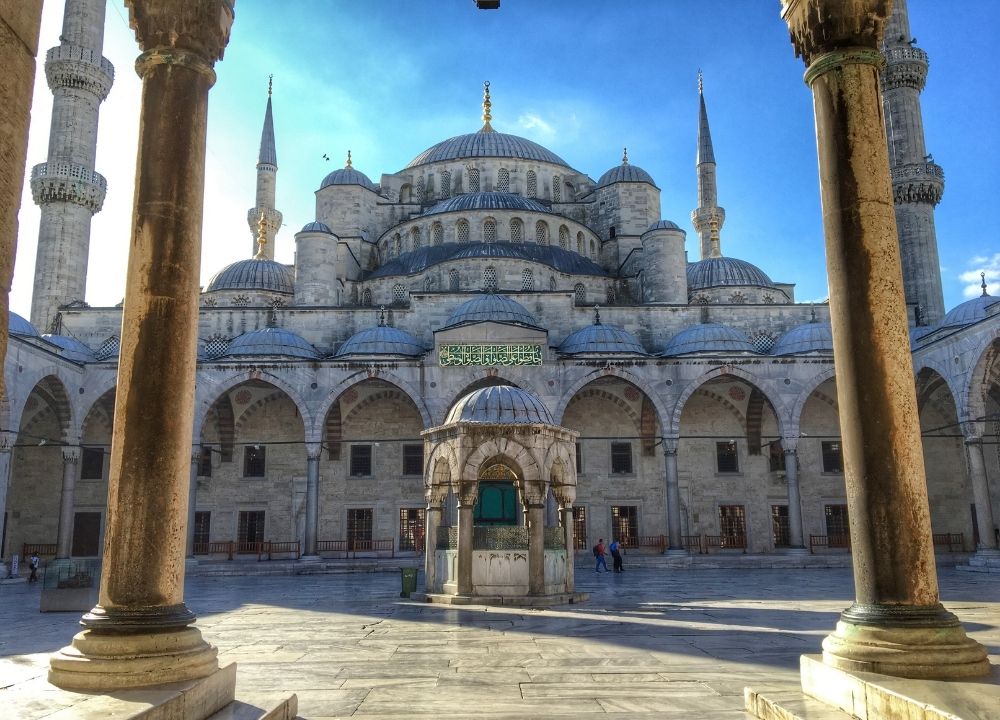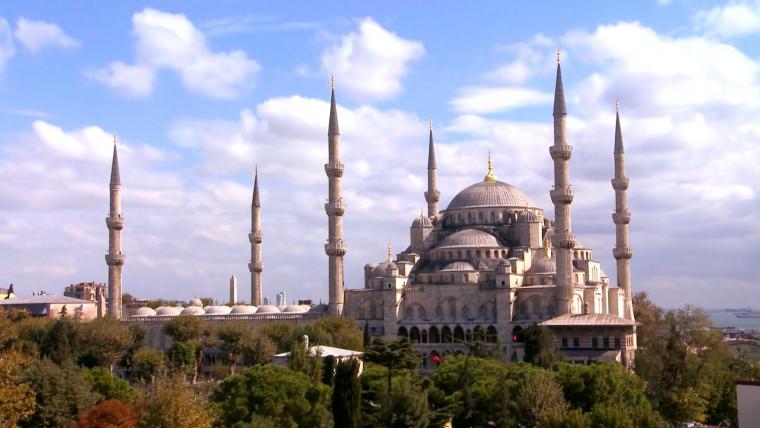Soaring Minarets & Dazzling Tiles: Dive into Istanbul's Blue Mosque

If you are planning a trip to Istanbul, one of the destinations that should be on your itinerary is the Blue Mosque. This iconic landmark is a beautiful and historic mosque that attracts millions of visitors annually. This blog post will give you a brief history of the Blue Mosque, its importance and its architecture.
History and Significance of the Blue Mosque
The Blue Mosque, also known as the Sultan Ahmed Mosque, was built between 1609 and 1616 during the rule of Sultan Ahmed I. The mosque is named after the sultan who ordered its construction.
The mosque is significant in Islamic history because it was built when Istanbul was the Ottoman Empire's centre, and Islam flourished in the region. During the mosque's construction, it was important to the sultan that it be one of the most grandiose structures in the Islamic world.
One of the most noticeable features of the Blue Mosque is its stunning blue tiles that decorate the interior walls. There are more than 20,000 of these tiles that were hand-painted by skilled artisans. The mosque is also known for its six minarets, a significant detail as it was only reserved for the Muslim holy city of Mecca.
In addition to its architectural significance, the Blue Mosque continues to function. It is open for prayers, and visitors are welcome to experience the beauty and grandeur of the mosque's interior.
The Blue Mosque is a beautiful and important landmark with significant historical and religious value for Muslims and non-Muslims. If you plan a trip to Istanbul, visiting this magnificent mosque should be on your itinerary.

Exterior Architecture
If you are visiting Istanbul, the Blue Mosque is a must-see landmark, not only for its historical and religious significance but also for its stunning architecture. In this blog post, we will give you an overview of the exterior architecture of the Blue Mosque, including details about its domes and minarets.
Overview of Exterior Architecture
The Blue Mosque's exterior combines Ottoman and Byzantine architectural styles. The mosque is mainly constructed of marble and brick, and its main entrance is a large courtyard with fountains, and ablution taps for worshippers to purify themselves before prayer. The courtyard is surrounded by arched colonnades with traditional Ottoman patterns and decorated with green, blue and white tiles.
Details about domes and minarets
Several large domes and six minarets characterize the Blue Mosque's architecture. The central dome has a diameter of 23.5 meters and sits atop four half-domes supported by four columns. The dome and half-dome interiors are decorated with intricate patterns, calligraphy and geometric shapes. The mosque's six minarets are tall, thin towers with balconies that call worshippers to prayer. Interestingly, when the mosque was built, it drew criticism for having six minarets, traditionally only allowed for the Muslim holy city of Mecca.
The Blue Mosque's exterior architecture perfectly blends Ottoman and Byzantine styles, with its stunning domes and minarets drawing visitors worldwide.
Interior Design
If you were awed by the exterior architecture of the Blue Mosque, wait until you see its jaw-dropping interiors. The mosque's ornate design begs to be explored, from the intricate stonework to the beautiful tiles adorning its walls. In this blog post, we will give you a quick guide to the interior design of the Blue Mosque.
Overview of interior design
The interior of the Blue Mosque boasts a vast space filled with natural light streaming through the mosque’s 260 windows, creating a tranquil ambience. The walls are covered with delicate tiles in a kaleidoscope of colours, including blue, green, and turquoise, and the beautiful chandeliers overhead illuminate the mosque with elegant light. The mihrab, which marks the direction of Mecca, is also very impressive and ornately embellished, and simple glass lamps hang from the ceiling, casting a warm glow over the space.
Details about tiles, calligraphy, and ornamentation
The mosque's intricate tilework is truly a spectacle to admire. Each tile is hand-painted and specially designed, featuring floral motifs, geometric shapes, and Arabic calligraphy. Along with the tilework, the interior features exquisite ornamentation, such as the carved marble of the columns and gables with gold accents, adding to this holy site's impressive beauty.
The Blue Mosque's interior design is a sight to behold, and it's hard not to be fascinated by its beauty. It's easy to feel humbled by the awe-inspiring elegance of the mosque's intricate details; it's a testament to the artisans' dedication and skill.

Mihrab and Mimbar
If you visited the Blue Mosque, you must have noticed its stunning interiors. The mosque's interior design reflects Islamic architecture's grandeur, making the mosque one of Istanbul's most visited attractions. Aside from the awe-inspiring tilework and chandeliers, two pieces add more to the interior's beauty: the mihrab and mimbar. In this blog post, we will describe these pieces and their significance.
Description of mihrab and mimbar
The mihrab is an ornate niche in the mosque's wall that indicates the direction of Mecca. It is the focal point of the mosque, and during prayers, worshippers face towards it. The mihrab of the Blue Mosque is made of finely carved marble with intricate decoration accents. It also features Arabic calligraphy that enhances the beauty of the niche.
Conversely, the mimbar is a raised platform where the imam stands to deliver sermons or speeches. It is typically made of wood and features delicate carvings and decorations. The mimbar at the Blue Mosque is approximately 13 feet tall and is one of the mosque's focal points, similar to the mihrab.
Significance in Islamic architecture
The mihrab and mimbar are essential elements in Islamic architecture. They symbolize the unity of Muslims worldwide, as they all direct their prayers towards Mecca, making it an essential part of any mosque's interior design, including the Blue Mosque. The designs of these pieces at the Blue Mosque feature intricate decorations that display the exceptional skills of the artisans who created them.

Courtyard
You might have marvelled at its grand courtyard if you visited the Blue Mosque. Let us explore the details of its design and significance in this blog.
Overview of courtyard design
The courtyard is essential to Islamic architecture and design, providing space and tranquillity for prayer and contemplation. The courtyard of the Blue Mosque is rectangular and features a large central dome and four smaller domes.
The courtyard's flooring is made of white marble, adorned with intricate patterns and designs, adding to its visual appeal. The arches surrounding the courtyard are intricately decorated with tiles and Arabic calligraphy, making it a beautiful spot to take pictures.
Details about fountains and ablution areas
The courtyard has two fountains worshippers use to perform ablution, a necessary cleansing ritual before prayer. The fountains are made of marble and decorated with intricate tilework, making them stunning art pieces.
In addition to the fountains, the courtyard has several ablution areas for worshippers to carry out the necessary cleansing ritual before prayer. These washing areas have marble benches and richly decorated arches lined with tiles and mosaics, adding to the courtyard's charm.
The courtyard of the Blue Mosque is a serene and beautiful space imbued with history and Islamic religious symbolism. It is a must-visit location for anyone interested in the architecture and culture of Istanbul.

Prayer Hall
As you move from the courtyard into the interior of the Blue Mosque, you enter the prayer hall, a sacred space for worshippers. Here are some details about the prayer hall's design and significance.
Details about the prayer hall layout
The prayer hall's layout is rectangular, with a central dome and several smaller domes. The central dome is 23.5 meters high and has a diameter of 33.5 meters, making it one of the largest domes in the world. The prayer hall can accommodate up to 10,000 worshippers at once, making it one of the biggest in Istanbul.
The prayer hall's flooring is covered in carpets, providing a comfortable prayer surface. The walls are covered in tiles with intricate floral and geometric designs, adding to the hall's beauty. The mihrab, a semicircular niche in the wall that indicates the direction of Mecca, is made of finely carved marble and is decorated with calligraphy.
Importance of symmetry and proportion
The prayer hall's design emphasizes symmetry and proportion, following the principles of Islamic architecture. The central dome is supported by four massive marble pillars that symbolize the four caliphs of early Islam. The smaller domes and arches create a sense of harmony and balance, creating a tranquil atmosphere for prayer and contemplation.
The prayer hall of the Blue Mosque is a beautiful example of Islamic architecture and design, a testament to the skill and creativity of the builders and craftsmen who created it. Whether you are a religious pilgrim or a curious traveller, it is a must-see location in Istanbul.

Restoration and Preservation Efforts
As a historic landmark, the Blue Mosque has undergone several restoration and preservation efforts to maintain its beauty and structural integrity over the years. Here are some details about these efforts.
History of restoration and preservation efforts
The first restoration of the Blue Mosque took place in the mid-19th century, during which minor repairs were made to the structure. In the 20th century, more extensive conservation efforts were conducted to repair damage caused by earthquakes and ageing and restore the mosque's intricate tilework and calligraphy.
Current efforts to maintain the Blue Mosque
Today, the Turkish Ministry of Culture and Tourism oversees the maintenance and preservation of the Blue Mosque. Regular cleaning and restoration work is done on the mosque's exterior facade and interior structures, including the prayer hall, to prevent decay and damage.
In recent years, the Blue Mosque has been the subject of controversy due to concerns about overcrowding and damage caused by tourism. In response, the Turkish government has implemented measures to limit visitor numbers and regulate tourist behaviour within the mosque, such as discouraging flash photography and imposing a dress code.
Overall, the restoration and preservation efforts of the Blue Mosque aim to ensure that this remarkable example of Islamic architecture and design can be enjoyed by generations to come.

Visiting the Blue Mosque
If you're planning a trip to Istanbul, visiting the Blue Mosque is a must-see attraction. Here's what you need to know before you go:
Information about visiting hours and dress code
The Blue Mosque is open every day of the week except during religious holidays and ceremonies. Visiting hours are from 9 a.m. to 9 p.m., although these times may vary depending on the season.
Visitors must remove their shoes when entering the mosque, and women must cover their heads with a scarf. In addition, men and women must wear clothing covering the arms and legs to show respect for the mosque's religious significance.
Tips for tourists
During peak tourist season, the Blue Mosque can get very crowded. Visiting early in the morning or later in the evening is best to avoid the crowds.
Flash photography is prohibited inside the mosque, and visitors are asked to keep noise levels minimal. Remember to respect other visitors and the mosque's importance as a religious site.
Finally, if you're interested in learning more about the history and architecture of the Blue Mosque, consider hiring a guide or taking a guided tour.
Overall, visiting the Blue Mosque is a unique and unforgettable experience that offers a glimpse of Istanbul's rich cultural heritage. By following the mosque's dress code and rules of conduct, visitors can show their respect for this important religious landmark.
